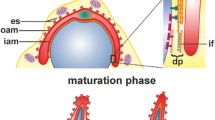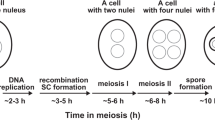Abstract
Stable actin structures play important roles in the development and specialization of differentiated cells. How these structures form, are organized, and are used to mediate physiological processes is not well understood in most cases. In Drosophila testis, stable actin structures, called actin cones, mediate spermatid individualization, a large-scale cellular remodeling process. These actin cones are composed of two structural domains, a front meshwork and a rear region of parallel bundles. Myosin VI is an important player in proper actin cone organization and function. Myosin VI localizes to the cones' fronts and its specific localization is required for proper actin cone formation and function during individualization. To understand how these structures are organized and assembled, ultrastructural studies are important to reveal both organization of actin and the precise localization of actin regulators relative to regions with different filament organizations. In the present work, we have developed a novel pre-embedding immunogold-silver labeling method for high-resolution analysis of protein distribution in actin structures which allowed both satisfactory antibody labeling and good ultrastructural preservation. Electron microscopic studies revealed that myosin VI accumulated at the extreme leading edge of the actin cone and preferentially localized throughout the front meshwork of the cone where branched actin filaments were most concentrated. No myosin VI labeling was found adjacent to the membranes along the length of the cone or connecting neighboring cones. This method has potential to reveal important information about precise relationships between actin-binding proteins, membranes, and different types of actin structures.






Similar content being viewed by others
Abbreviations
- BSA:
-
Bovine serum albumin
- EM:
-
Electron microscopy
- JLA20:
-
Anti-actin antibody
- MAb:
-
Monoclonal antibody
- PB:
-
Phosphate buffer
- PBS:
-
Phosphate-buffered saline
- 3C7:
-
Anti-myosin VI antibody
References
Altman D, Sweeney HL, Spudich JA (2004) The mechanism of myosin VI translocation and its load-induced anchoring. Cell 116:737–749
Asano Y, Mabuchi I (2001) Calyculin-A, an inhibitor for protein phosphatases, induces cortical contraction in unfertilized sea urchin eggs. Cell Motil Cytoskeleton 48:245–261
Buss F, Arden SD, Lindsay M, Luzio JP, Kendrick-Jones J (2001) Myosin VI isoform localized to clathrin-coated vesicles with a role in clathrin-mediated endocytosis. EMBO J 20:3676–3684
Chuan P, Spudich JA, Dunn AR (2011) Robust mechanosensing and tension generation by myosin VI. J Mol Biol 405:105–112
Cross DP, Shellenbarger DL (1979) The dynamics of Drosophila melanogaster spermatogenesis in in vitro cultures. J Embryol Exp Morphol 53:345–351
Dancker P, Löw I, Hasselbach W, Wieland T (1975) Interaction of actin with phalloidin: polymerization and stabilization of F-actin. Biochim Biophys Acta 400:407–414
Fabrizio JJ, Hime G, Lemmon SK, Bazinet C (1998) Genetic dissection of sperm individualization in Drosophila melanogaster. Development 125:1833–1843
Frank DJ, Noguchi T, Miller KG (2004) Myosin VI: a structural role in actin organization important for protein and organelle localization and trafficking. Curr Opin Cell Biol 16:189–194
Furness DN, Katori Y, Mahendrasingam S, Hackney CM (2005) Differential distribution of β- and γ-actin in guinea-pig cochlear sensory and supporting cells. Hear Res 207:22–34
Hasson T, Gillespie PG, Garcia JA, MacDonald RB, Zhao Y, Yee AG, Mooseker MS, Corey DP (1997) Unconventional myosins in inner-ear sensory epithelia. J Cell Biol 137:1287–1307
Hicks JL, Deng WM, Rogat AD, Miller KG, Bownes M (1999) Class VI unconventional myosin VI is required for spermatogenesis in Drosophila. Mol Biol Cell 10:4341–4353
Kellerman KA, Miller KG (1992) An unconventional myosin heavy chain gene from Drosophila melanogaster. J Cell Biol 119:823–834
Marchelletta RR, Jakobs DT, Schechter JE, Cheney RE, Hamm-Alvares SF (2008) The class V myosin motor, myosin 5c, localizes to mature secretory vesicles and facilitates exocytosis in lacrimal acini. Am J Physiol Cell Physiol 295:C13–C28
Margossian SS, Lowey S (1982) Preparation of myosin and its subfragments from rabbit skeletal muscle. Meth Enzymol 85B:55–71
Ménétrey J, Bahloul A, Wells AL, Yengo CM, Morris CA, Sweeney HL, Houdusse A (2005) The structure of the myosin VI motor reveals the mechanism of directionality reversal. Nature 435:779–785
Morriswood B, Ryzhakov G, Puri C, Arden SD, Roberts R, Dendrou C, Kendrick-Jones J, Buss F (2007) T6BP and NDP52 are myosin VI binding partners with potential roles in cytokine signaling and cell adhesion. J Cell Sci 120:2574–2585
Noguchi T, Miller KG (2003) A role of actin dynamics in individualization during spermatogenesis in Drosophila melanogaster. Development 130:1805–1816
Noguchi T, Lenartowska M, Miller KG (2006) Myosin VI stabilizes an actin network during Drosophila spermatid individualization. Mol Biol Cell 17:2559–2571
Noguchi T, Lenartowska M, Rogat AD, Frank DJ, Miller KG (2008) Proper cellular organization during Drosophila individualization depends on actin structures composed of two domains, bundles and meshwork that are differentially regulated and have different functions. Mol Biol Cell 19:2363–2372
Puri C, Chibalina MV, Arden SD, Kruppa A, Kendrick-Jones J, Buss F (2010) Overexpression of myosin VI in prostate cancer cells enhances PSA and VEGF secrecion, but has no effect on endocytosis. Oncogene 29:188–2000
Rogat AD, Miller KG (2002) A role for myosin VI in actin dynamics at sites of membrane remodeling during Drosophila spermatogenesis. J Cell Sci 115:4855–4865
Roux I, Hosie S, Johnson SL, Bahloul A, Cayet N, Nouaille S, Kros CJ, Petit C, Safieddine S (2009) Myosin VI is required for the proper maturation and function of inner hair cell ribbon synapses. Hum Mol Genet 18:4615–4628
Rzadzinska AK, Schneider ME, Davies C, Riordan GP, Kachar B (2004) An actin molecular treadmill and myosins maintain stereocilia functional architecture and self-renewal. J Cell Biol 164:887–897
Sobczak M, Wasik A, Kłopocka W, Rędowicz MJ (2008) Involvement of myosin VI immunoanalog in pinocytosis and phagocytosis in Amoeba proteus. Biochem Cell Biol 86:509–519
Stromer MH, Mayes MS, Bellin RM (2002) Use of actinisoform-specific antibodies to probe the domain structure in three smooth muscles. Histochem Cell Biol 118:291–299
Sweeney HL, Houdusse A (2007) What can myosin VI do in cells? Curr Opin Cell Biol 19:57–66
Sweeney HL, Houdusse A (2010) Myosin VI rewrites the rules for myosin motors. Cell 141:573–582
Tokuyasu KT, Peacock WJ, Hardy RW (1972) Dynamics of spermatogenesis in Drosophila melanogaster. I. Individualization process. Z Zellforsch Mikrosk Anat 124:479–506
Warner CL, Stewart A, Luzio JP, Steel KP, Libby RT, Kendrick-Jones J, Buss F (2003) Loss of myosin VI reduces secretion and the size of the Golgi in fibroblasts from Snell's waltzer mice. EMBO J 22:569–579
Wells AL, Lin AW, Chen LQ, Safer D, Cain SM, Hasson T, Carragher BO, Milligan RA, Sweeney HL (1999) Myosin VI is an actin-based motor that moves backwards. Nature 401:505–508
Acknowledgments
We thank Michał Świdziński and Olga Narbutt for their technical assistance, and Deborah J Frank for the critical reading of this manuscript. This work was supported by a grant from Polish Ministry of Science and Higher Education, grant number no. N303 816240 and by the National Institutes of Health Grant R01GM-60494 (to K.G.M.).
Conflict of interest
None.
Author information
Authors and Affiliations
Corresponding author
Additional information
Handling Editor: Pavel Dráber
Rights and permissions
About this article
Cite this article
Lenartowska, M., Isaji, M. & Miller, K.G. A pre-embedding immunogold approach reveals localization of myosin VI at the ultrastructural level in the actin cones that mediate Drosophila spermatid individualization. Protoplasma 249, 337–346 (2012). https://doi.org/10.1007/s00709-011-0284-3
Received:
Accepted:
Published:
Issue Date:
DOI: https://doi.org/10.1007/s00709-011-0284-3




